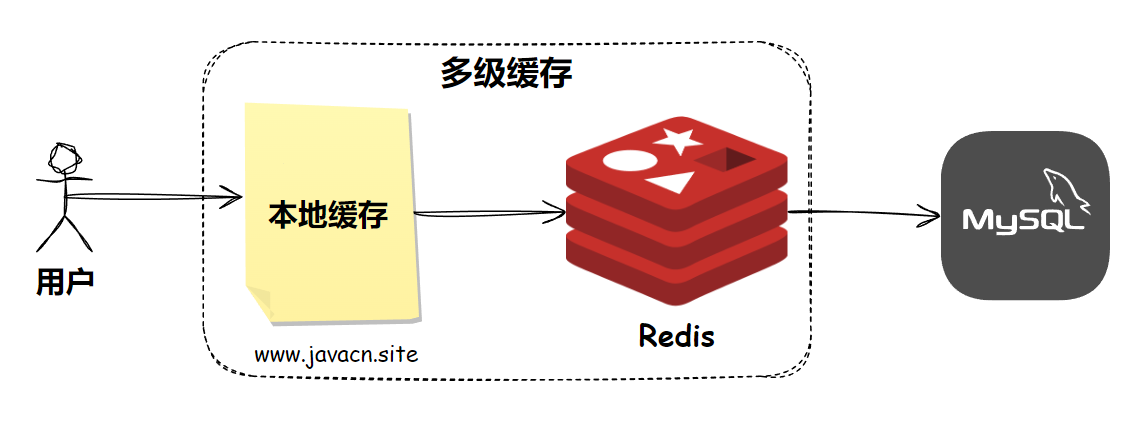
我们提供安全,免费的手游软件下载!
本地缓存是将数据存储在应用程序所在的本地内存中的缓存方式 。尽管已经有 Redis 缓存了,但本地缓存也是非常有必要的,因为它有以下优点。
尽管已经有 Redis 缓存了,但本地缓存也是非常有必要的,因为它有以下优点:
因此,在生产环境中,我们 通常使用本地缓存+Redis 缓存一起组合成多级缓存,来共同保证程序的运行效率 。
多级缓存是一种缓存架构策略,它使用多个层次的缓存来存储数据,以提高数据访问速度和系统性能,最简单的多级缓存就是由本地缓存 + Redis 分布式缓存组成的。

多级缓存在获取时的实现代码如下:
public Object getFromCache(String key) {
// 先从本地缓存中查找
Cache.ValueWrapper localCacheValue = cacheManager.getCache("localCache").get(key);
if (localCacheValue!= null) {
return localCacheValue.get();
}
// 如果本地缓存未命中,从 Redis 中查找
Object redisValue = redisTemplate.opsForValue().get(key);
if (redisValue!= null) {
// 将 Redis 中的数据放入本地缓存
cacheManager.getCache("localCache").put(key, redisValue);
return redisValue;
}
return null;
}
本地缓存常见的方式实现有以下几种:
它们的基本使用如下。
在 pom.xml 文件中添加 Ehcache 依赖:
org.springframework.boot
spring-boot-starter-cache
org.ehcache
ehcache
在 src/main/resources 目录下创建 ehcache.xml 文件:
在 Spring Boot 应用的主类或配置类上添加 @EnableCaching 注解:
import org.springframework.boot.SpringApplication;
import org.springframework.boot.autoconfigure.SpringBootApplication;
import org.springframework.cache.annotation.EnableCaching;
@SpringBootApplication
@EnableCaching
public class CacheApplication {
public static void main(String[] args) {
SpringApplication.run(CacheApplication.class, args);
}
}
创建一个服务类并使用 @Cacheable 注解:
import org.springframework.cache.annotation.Cacheable;
import org.springframework.stereotype.Service;
@Service
public class MyService {
@Cacheable(value = "myCache", key = "#id")
public String getData(String id) {
// 模拟耗时操作
try {
Thread.sleep(1000);
} catch (InterruptedException e) {
e.printStackTrace();
}
return "Data for " + id;
}
}
在 pom.xml 文件中添加 Caffeine 依赖:
org.springframework.boot
spring-boot-starter-cache
com.github.ben-manes.caffeine
caffeine
在 Spring Boot 应用的主类或配置类上添加 @EnableCaching 注解:
import org.springframework.boot.SpringApplication;
import org.springframework.boot.autoconfigure.SpringBootApplication;
import org.springframework.cache.annotation.EnableCaching;
@SpringBootApplication
@EnableCaching
public class CacheApplication {
public static void main(String[] args) {
SpringApplication.run(CacheApplication.class, args);
}
}
创建一个配置类来配置 Caffeine 缓存:
import com.github.benmanes.caffeine.cache.Caffeine;
import org.springframework.cache.CacheManager;
import org.springframework.cache.caffeine.CaffeineCacheManager;
import org.springframework.context.annotation.Bean;
import org.springframework.context.annotation.Configuration;
@Configuration
public class CacheConfig {
@Bean
public CacheManager cacheManager() {
CaffeineCacheManager cacheManager = new CaffeineCacheManager("myCache");
cacheManager.setCaffeine(Caffeine.newBuilder()
.maximumSize(1000)
.expireAfterWrite(120, TimeUnit.SECONDS));
return cacheManager;
}
}
创建一个服务类并使用 @Cacheable 注解:
import org.springframework.cache.annotation.Cacheable;
import org.springframework.stereotype.Service;
@Service
public class MyService {
@Cacheable(value = "myCache", key = "#id")
public String getData(String id) {
// 模拟耗时操作
try {
Thread.sleep(1000);
} catch (InterruptedException e) {
e.printStackTrace();
}
return "Data for " + id;
}
}
在 pom.xml 文件中添加 Guava 依赖:
org.springframework.boot
spring-boot-starter-cache
com.google.guava
guava
在 Spring Boot 应用的主类或配置类上添加 @EnableCaching 注解:
import org.springframework.boot.SpringApplication;
import org.springframework.boot.autoconfigure.SpringBootApplication;
import org.springframework.cache.annotation.EnableCaching;
@SpringBootApplication
@EnableCaching
public class CacheApplication {
public static void main(String[] args) {
SpringApplication.run(CacheApplication.class, args);
}
}
创建一个配置类来配置 Guava 缓存:
import com.google.common.cache.CacheBuilder;
import org.springframework.cache.Cache;
import org.springframework.cache.CacheManager;
import org.springframework.cache.concurrent.ConcurrentMapCache;
import org.springframework.cache.concurrent.ConcurrentMapCacheManager;
import org.springframework.context.annotation.Bean;
import org.springframework.context.annotation.Configuration;
import java.util.concurrent.TimeUnit;
@Configuration
public class CacheConfig {
@Bean
public CacheManager cacheManager() {
ConcurrentMapCacheManager cacheManager = new ConcurrentMapCacheManager() {
@Override
protected Cache createConcurrentMapCache(String name) {
return new ConcurrentMapCache(name,
CacheBuilder.newBuilder()
.maximumSize(1000)
.expireAfterWrite(120, TimeUnit.SECONDS)
.build().asMap(), false);
}
};
return cacheManager;
}
}
创建一个服务类并使用 @Cacheable 注解:
import org.springframework.cache.annotation.Cacheable;
import org.springframework.stereotype@Service;
@Service
public class MyService {
@Cacheable(value = "myCache", key = "#id")
public String getData(String id) {
// 模拟耗时操作
try {
Thread.sleep(1000);
} catch (InterruptedException e) {
e.printStackTrace();
}
return "Data for " + id;
}
}
在 Spring 框架中,@Cacheable、@CachePut 和 @CacheEvict 是用于缓存管理的注解,它们的含义如下:
@Cacheable(value = "users", key = "#id")
public User getUserById(String id) {
// 模拟从数据库中获取用户信息
System.out.println("Fetching user from database: " + id);
return new User(id, "User Name " + id);
}
@CachePut(value = "users", key = "#user.id")
public User updateUser(User user) {
// 模拟更新数据库中的用户信息
System.out.println("Updating user in database: " + user.getId());
// 假设更新成功
return user;
}
@CacheEvict(value = "users", key = "#id")
public void deleteUser(String id) {
// 模拟从数据库中删除用户信息
System.out.println("Deleting user from database: " + id);
}
// 清除整个缓存,而不仅仅是特定的条目
@CacheEvict(value = "users", allEntries = true)
public void clearAllUsersCache() {
System.out.println("Clearing all users cache");
}
生产环境通常会使用本地缓存 + Redis 缓存,一起实现多级缓存,以提升程序的运行效率,而本地缓存的常见实现有 Ehcache、Caffeine、Guava Cache 等。然而,凡事有利就有弊,那么多级缓存最大的问题就是数据一致性问题,对于多级缓存的数据一致性问题要如何保证呢?
本文已收录到我的面试小站 www.javacn.site ,其中包含的内容有:并发编程、MySQL、Redis、Spring、Spring MVC、Spring Boot、Spring Cloud、MyBatis、JVM、设计模式、消息队列等模块。
热门资讯